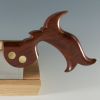I finally set up my iBox that and made some ¼” box joints for trays for a jewelry box. Read the directions, watched the DVD and went to work. Assembly was easy, as are all Incra products. Using the jig is intuitive, like most any box joint jig. A few test cuts on some scrap pieces set the joint tolerance perfectly, and I knocked out a couple of tray boxes in a few minutes. That is after a mis-cut on one of the box sides.
A couple of observations and a slight mod to the jig:
1. I was making shallow boxes for trays that fit into a jewelry box. One tray is approx 15” L x 7.5” W x 2-1/4” deep. The other is 7.5” x 7.5” x 1-3/4” deep. Stock is ¼” thick. I found it took a little finesse and double checking to make sure that the edge of the stock remained flat on the blade side stock ledge while trying to clamp it to the fence for the first cut. There is not much of the stock sitting on the ledge and about half of it floats out in space over the blade while contacting the pin plates. The pin plates are below the stock ledges so there is nothing to keep such narrow stock ‘square to the ledge and parallel to the blade. On my first cut, the stock shifted a bit while clamping it to the fence, causing the miss-cut. I was careful after that to double check that my stock was seated correctly. I’m not sure how you could resolve this, due to the design of the iBox. The opening is quite large, due to its versatility for various width joints. If anyone has any ideas, I’d appreciate it. I do a lot of shallow boxes for jewelry cases, etc. and would like to make the first cut easier to dial in.
2. As with the Incra LS super system on my router table, I’d like a better clamping system for the iBox, other than a hand screw. During my test cut, I screwed the workpiece to the fence, but one of the screws on the clamp was not riding flat on the fence. As I pushed the piece through the blade, I hit the screw and it moved downward flush to the fence and the workpiece shifted out of square. Not a biggie, as this was a test cut and my first cut with the jig. Just cut another one and calibrated the pin plate separation. But, I find it a cumbersome clamping process for such sophisticated jigs and fences. On the LS supersystem on my router table, there are T-slots on the right angle fence. There is a T-slot on the rear of the iBox fence as well. Maybe these can be used to design a clamp that slides in these slots to hold the stock tight to the fence. Maybe a cam lever clamp or something of the sort. IMO, there is too much going on having to maneuver the hand screw while fitting the stock for the next cut and keeping it flat to the stock ledge. Not a deal breaker, but possibly an improvement on its ease of use.
I also did a small mod to my iBox. I have a small shop, with limited wall and storage space. I kept looking at the clear deflector shield sticking out from the front of the jig, wondering when I was going to break it off as I shuffled it from storage to table saw. As it is held in place with wood screws and washers, I wouldn’t want to constantly screw it on and off, compromising the integrity of the MDF blade guard. I had some ¼” hanger bolts and brass knurl knobs in my hardware bins that did just the trick.
IMAG0048.jpg IMAG0050.jpg
I removed the deflector, and on my DP bored out the screw holes in the front blade guard with a 13/64” bit and the holes on the deflector with a 17/64” bit. Screwed the lag side of the hanger bolt into the blade guard, slipped the deflector shield on and secured it with a couple of washers and knurl knobs.
IMAG0046.jpg IMAG0047.jpg
When I’m finished using the jig, unscrew the knurls, take the shield off, store it behind the blade guard and screw the knurls back on. Less space to store and less chance of me whacking the shield and cracking it.
IMAG0049.jpg
All in all, I’m happy with the iBox. Beats making custom box joint jigs for each size. I think the accuracy and repeatability is better with this jig as well. It’s a welcome addition to my shop.




 Reply With Quote
Reply With Quote





